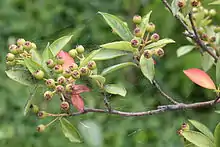× Sorbaronia mitschurinii
× Sorbaronia mitschurinii, also known as Sorbaronia mitschurinii, is a domesticated species that was known until recently under the name Aronia mitschurinii.[2] It has been considered to be a group of cultivars of Aronia melanocarpa, common ones including 'Viking' and 'Nero'. Genetic testing indicates it is likely a hybrid between A. melanocarpa and Sorbus aucuparia (mountain ash)[3] that apparently originated in cultivation.[2][4]
| × Sorbaronia mitschurinii | |
|---|---|
 | |
| Young fruit of cultivar 'Viking' | |
| Scientific classification | |
| Kingdom: | |
| (unranked): | |
| (unranked): | |
| (unranked): | |
| Order: | |
| Family: | |
| Subfamily: | |
| Tribe: | |
| Subtribe: | |
| Genus: | × Sorbaronia |
| Species: | × S. mitschurinii |
| Binomial name | |
| × Sorbaronia mitschurinii | |
Hypothesized origin
S. mitschurinii has been suggested to be the product of Russian pomologist Ivan Vladimirovich Michurin's early 20th-century experiments in wide hybridizations.[4]
Description
This species is more robust than wild populations of Aronia melanocarpa; the leaves are broader, and the fruits larger.[2][3] It is tetraploid[3] and self-fertile.[5]
Uses
Sorbaronia mitschurinii has historically seen extensive cultivation in the former Soviet Union[6] as its large fruits are suitable for juice, wine, and jam-making, and because they are self-fertile, requiring only one plant to produce fruit.[5]
Like other Aronia, the fruit is used as a flavoring or colorant for beverages or yogurts.[5] Juice from the ripe berries is astringent, sweet (with high sugar content), sour (low pH), and contains vitamin C. In addition to juice, the fruit can be baked into soft breads.[5] In the U.S., Aronia berries are also marketed for their antioxidant properties.
Similar hybrids
Other intergeneric hybrids within tribe Maleae that include Sorbus as one of the parents are:
- × Amelasorbus
- × Crataegosorbus
- × Malosorbus
- × Sorbocotoneaster
- × Sorbopyrus
References
| Wikimedia Commons has media related to Aronia mitschurinii. |
- Potter, D., et al. (2007). Phylogeny and classification of Rosaceae. Plant Systematics and Evolution. 266(1–2): 5–43. [Referring to the subfamily by the name "Spiraeoideae"]
- Skvortsov, A.K. & Yu.K. Maitulina (1982). Translated by Irina Kadis. "On distinctions of cultivated black-fruited Aronia from its wild ancestors". Bulletin of the Central Botanical Garden, AN SSSR. 126: 35–40.
- Leonard, P.L.; M.H Brand; B.A. Connolly & S.G. Obae (2013). "Investigations into the origin of Aronia mitschurinii using amplified fragment length polymorphism analysis". HortScience. 48 (5): 520–524.
- Skvortsov, A.K., Yu.K. Maitulina, and Y.N. Gorbunov. 1983. Cultivated black-fruited Aronia: Place, time, and probable mechanism of formation. Bull. MOIP. Otd. Biol. 88:88-96 translation by Irina Kadis
- Steven A. McKay (March 17, 2004). "Demand increasing for aronia and elderberry in North America" (PDF). New York Berry News. 3 (11).
- Kask, K. (1987). "Large-fruited black chokeberry (Aronia melanocarpa)". Fruit Varieties Journal. pp. 47–47.